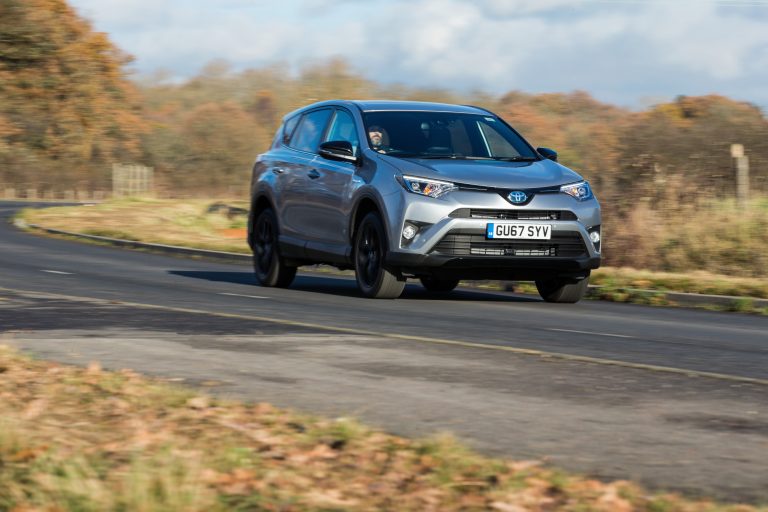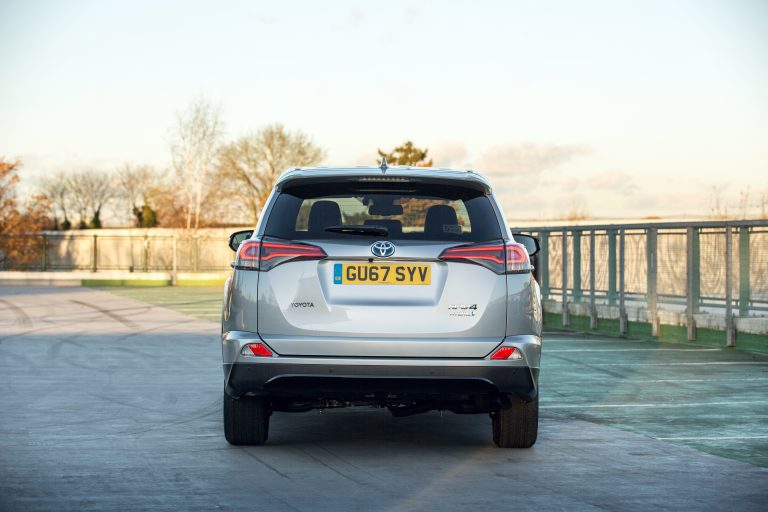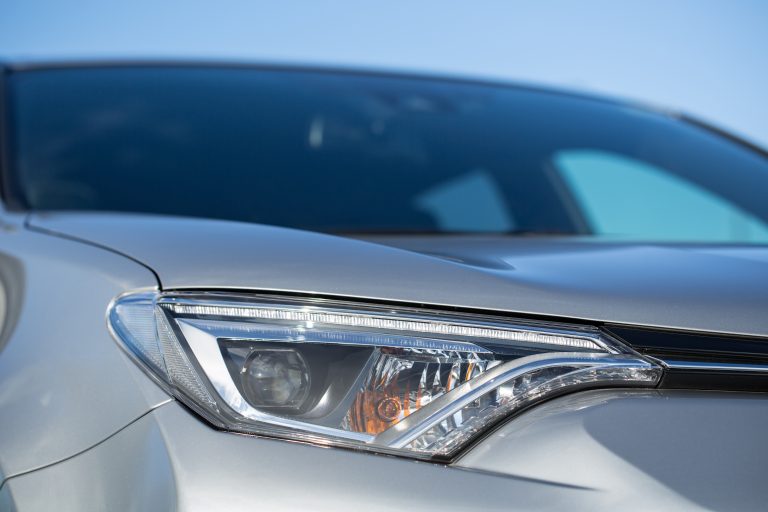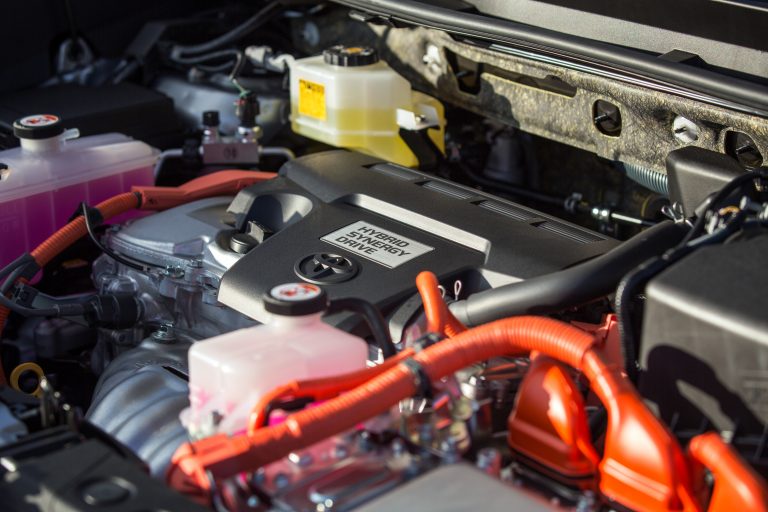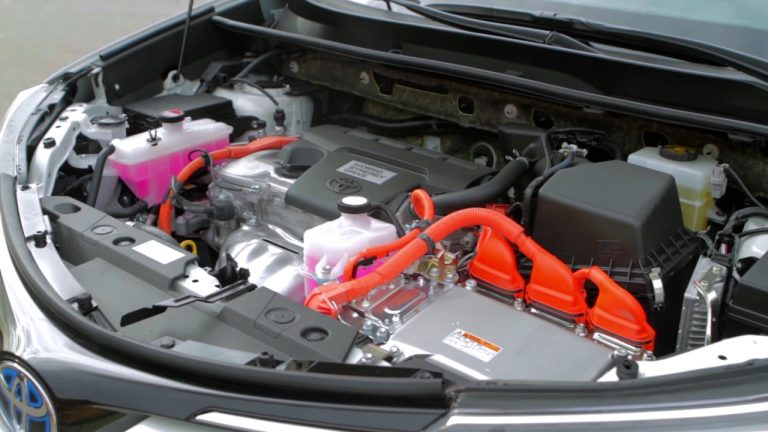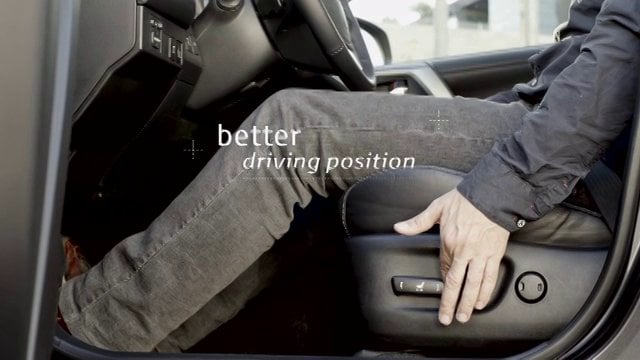Frankfurt Motor Show: The New Toyota RAV4 Hybrid
- European debut of the new RAV4 Hybrid
- Hybrid SUV to be offered in both two-wheel and E-Four all-wheel drive versions
- AWD model provides strong 1,650kg towing capacity
- Revised RAV4 range also to feature new 141bhp 2.0-litre D-4D engine
Click here for more images of new RAV4 Hybrid
Note to editors: this information relates to international markets, UK equipment and technical specifications and model availability will be announced later.
Toyota will take its full hybrid technology into the highly competitive European compact SUV segment for the first time with the 2016 launch of the new RAV4 Hybrid.
Both front and all-wheel drive versions will be available, powered by a hybrid system that uses a 2.5-litre Atkinson cycle petrol engine and a powerful electric motor. The AWD model has an additional electric motor at the rear that provides extra traction and a 1,650kg towing capability, without the added weight and complexity of central prop shaft.
Total system output is 195bhp/145kW, giving seamless acceleration from rest to 62mph in 8.7 seconds. Combined cycle fuel consumption is a class-leading 57.7mpg, while CO2 emissions are from a highly tax-efficient 115g/km (figures subject to homologation).
The hybrid leads a revised, Euro 6-compliant engine line-up for RAV4. This includes a new 2.0-litre D-4D turbodiesel offering 141bhp/105kW and a substantial 320Nm of torque, while at the same time targeting 123g/km CO2 emissions. There is also an improved 149bhp/11kW 2.0-litre Valvematic petrol unit that is already on sale and available with a choice of manual transmission or CVT (CVT only in the UK). This musters 195Nm of torque and CO2 emissions from 149g/km.
Going beyond the smooth and refined Toyota hybrid driving experience, the new RAV4 further benefits from improved ride comfort, dynamic performance and cabin quietness. There are also smart changes to the exterior design, higher levels of sensory quality in the interior, improved equipment functionality and innovations in safety and the application of advanced technology.
The introduction of Toyota Safety Sense provides a package of new active safety systems. A new panoramic view monitor is also available, providing a bird’s eye view of the vehicle’s immediate surroundings, making parking and low-speed manoeuvring easier. Inside, there is a new 4.2-inch multi-information screen set between the meters in the instrument binnacle and a seven-inch, full-colour centre console display, incorporating the Toyota Touch 2 multimedia system.
RAV4 heritage
Toyota can rightfully claim to have created the compact SUV market with the introduction of the first Recreational Active Vehicle with 4-wheel drive – RAV4 – in 1994.
The model’s debut at that year’s Geneva motor show revealed it as something quite different to a traditional 4×4. First offered as a compact (3,595mm-long) three-door, this original urban SUV was powered by a relatively small, transverse-mounted 2.0-litre engine. It featured independent suspension all round, and a monocoque chassis rather than the then-familiar SUV body-on-frame construction.
In that first year Toyota sold 53,000 RAV4; in 1995 the figure doubled, then tripled the year after that. Annual sales have since grown steadily with each successive generation, transforming RAV4 from a niche model into a global car. By 2013 its annual sales figures were 10 times greater than in 1994.
Today RAV4 is sold in 170 countries around the world; since launch, more than six million have reached the road, 1.5 million of these in Europe. At the same time, the compact SUV market has changed and matured. Customers originally bought these models as an alternative to sporty hatchbacks and coupes, but today sales growth is driven by families who want an engaging, fashionable, yet practical alternative to MPVs and estate cars.
Hybrid powertrain
RAV4 Hybrid’s full hybrid system comprises a 2.5-litre Atkinson cycle petrol engine, a powerful electric motor, a generator, a 204-cell nickel-metal hydride battery (located beneath the rear seats), a power control unit and a power split device.
On the AWD version there is a second, rear-mounted electric motor that provides electric all-wheel drive (E-four). This system avoids the added weight, cost and complexity of a mechanical system with a central prop shaft.
Total system output is 195bhp/145kW, giving nought to 62mph acceleration in 8.7 seconds and a top speed of 112mph. Combined cycle fuel consumption is a class-leading 57.7mpg and CO2 emissions are a tax-efficient 115g/km (figures subject to homologation).
The hybrid system uses power from the engine and electric motor in tandem, or from the electric motor alone, maximising the efficiency of both sources to achieve the best balance of driving performance and fuel economy.
During deceleration and under braking, the electric motors act as a high-output generator to provide regenerative braking – kinetic energy that would normally be lost as heat as the vehicle slows or brakes is recovered as electrical energy and stored in a high-performance battery.
The seamless, E-CVT electric continuously variable transmission uses shift-by-wire control, via an electronic shift lever. The driver can select from four drive modes which tailor hybrid system performance to suit driving conditions or personal preference. They include an EV mode, which gives near-silent running over short distances on electric power alone, with zero fuel consumption and tailpipe emissions – ideal for slow urban traffic conditions.
The system is designed to eliminate use of the petrol engine as much as possible when driving in city traffic. Toyota’s own data show that the cumulative effect of full hybrid operation leads to a high proportion of zero emissions EV driving.
E-Four electric AWD
In a first for a Toyota vehicle in Europe, the RAV4 Hybrid AWD is equipped with a 50kW high-voltage, high-speed rear electric motor, which gives the vehicle all-wheel drive capability without the need for a central prop shaft.
Called E-Four, this works independently from the front electric motor and drives the rear wheels alone. The vehicle will switch smoothly and automatically to all-wheel drive when travelling on slippery road surfaces or when pulling away from stationary, maximising traction, stability and controllability.
E-Four generates drive torque by making efficient use of power from the vehicle’s hybrid system, not only optimising all-wheel drive performance in different driving conditions, but also reducing energy losses, helping RAV4 Hybrid achieve better fuel economy than is usually associated with AWD vehicles.
The extra traction provided by E-Four also gives RAV4 Hybrid a 1,650kg towing capacity, one of the highest achieved by any hybrid vehicle.
Improved driving feel, sequential Shiftmatic and Power mode
The control logic in RAV4 Hybrid’s transmission has been designed to give a smooth, natural feeling under acceleration, with a close match between vehicle speed and engine revs, creating a more pleasant and engaging driving experience.
A more sporting drive is on offer thanks the addition of a sequential Shiftmatic gear change function and a selectable Power drive mode. When the driver uses sequential shifting, engine braking force is increased and, because engine revs are kept higher than in the normal “D” drive position, throttle response is sharper. When Power mode is selected, traction force is increased.
Driving dynamics
The new RAV4 benefits from numerous measures to improve ride comfort and driver involvement, without sacrificing stability or controllability.
The number of spot welds on the rear cross-member support has been increased from 105 to 138 and patches have been added to the rear suspension member and floor cross-member. The resulting increase in rear bodyshell rigidity not only improves vehicle stability, it also allows for better harshness damping, which in turn gives better ride quality.
The new RAV4 retains a Macpherson strut front and lightweight trailing arm double wishbone rear suspension set-up, but the shock absorbers and springs have been revised to give a flatter, more comfortable ride and better straight-line stability. The steering rack has more rigid fastening points, giving a better steering feel
A quieter cabin
Noise, vibration and harshness levels have been comprehensively improved, with an emphasis on comfort for rear seat passengers and making it easier to hold a conversation in the cabin when on the move.
Detailed measures include increasing the surface area of the floor silencer by 55 per cent; reshaping the rear finish plate; and adding sound absorbing material in locations around the rear deck to reduce road, tyre and exhaust noise.
Extra sound-absorbing material and an outer insulator on the door trim work to cut wind and road noise. The instrument panel silencer has been made larger to reduce the transmission of engine noise into the cabin.
Advanced safety technology
The new RAV4 adopts the Toyota Safety Sense package of active technologies to help prevent or mitigate a collision in different traffic situations.
They include a radar-controlled Pre-Collision System with a Pedestrian Detection function, Lane Departure Alert, Adaptive Cruise Control, Road Sign Assist and Automatic High Beam.
The Pre-Collision System operates from around 6mph up to the vehicle’s top speed. It monitors the road ahead and if it detects the risk of a collision it prompts the driver to brake with visual and audible warnings. It also primes the brakes to provide extra stopping force when the driver presses the brake pedal. If the driver doesn’t respond to the alerts, the system will automatically apply the brakes, reducing vehicle speed by about 25mph, or potentially even bringing the car to a complete stop, to prevent a collision or reduce the force of impact.
The system can also detect potential collisions with pedestrians, in the event of which automated braking will operate at relative speeds of between 6 and 49mph, reducing vehicle speed by about 19mph.
Adaptive Cruise Control helps the driver maintain a safe distance from the vehicle in front, using the same millimetre radar as the Pre-Collision System to detect vehicles ahead and determine their speed. It then adjusts the Toyota’s speed (within a set range) to ensure a safe distance between both vehicles. When the road ahead is clear, the system smoothly accelerates back to the selected cruising speed. This makes for smoother acceleration and deceleration in the ebb and flow of traffic.
The Lane Departure Alert system monitors lane markings on the road and helps prevent accidents and head-on collisions caused by a vehicle leaving its lane. If the vehicle starts to deviate from its lane without the turn indicators being used, the system alerts the driver with visual and audible warnings.
Road Sign Assist keeps drivers informed, even if they have driven past a road sign without noticing. It recognises signage such as speed limits and “no overtaking” warnings, and displays the information on the TFT multi-information screen in the instrument binnacle. If the driver exceeds the speed limit, the system will activate a warning light and buzzer.
Automatic High Beam helps ensure excellent forward visibility when driving at night. It detects both the headlights of oncoming vehicles, and the tail lights of vehicles ahead, automatically switching between high and low beams to avoid dazzling other drivers. As high beam is used more frequently, pedestrians and obstacles are easier and quicker to spot.
With a reduced risk of being involved in a collision, vehicles equipped with Toyota Safety Sense can benefit from lower insurance group ratings, reducing ownership costs. New RAV4 will also continue to offer Toyota’s Blind Spot Monitor and Rear Cross Traffic Alert systems within its safety provisions.
Panoramic View Monitor
RAV4’s new Panoramic View Monitor uses an array of four cameras located on the underside of each door mirror and on the front and rear of the vehicle to capture a real-time 360-degree bird’s-eye view of its immediate surroundings.
The monitor can still be used while the vehicle is parked, before it is put into gear and the parking brake is released, a feature unique to Toyota’s system.
It can present a combine the images from any of the four cameras to provide a composite view and provide guidance lines on the rear view monitor image to show the vehicle’s path to help with parking and low-speed manoeuvres.
The wide, 180-degree front and rear view projections allow the driver to check blind spots each side of the vehicle. The side cameras will still operate if the door mirrors are folded, while a panoramic zoom function can be used to home in on nearby objects that would otherwise be difficult to see.
4.2-inch multi-information screen
The new-look instrument binnacle in RAV4 gains a 4.2-inch TFT colour multi-information screen. The display is controlled using switchgear on the steering wheel and it can also be co-ordinated with the seven-inch centre console screen.
The variety of functions and information that can be accessed includes vehicle settings customisation, trip computer, Smart Stop & Start telemetry, hybrid powertrain energy monitor, turn-by-turn navigation and real-time AWD vehicle posture and steering lock indication.
Exterior design
The changes to RAV4’s exterior styling are most strongly evident at the front where there is more powerful interpretation of Toyota’s current design language. The Toyota emblem is set prominently within a slender upper grille which anchors new LED or halogen headlamp units, both of which incorporate LED daytime running lights.
The middle grille has been made wider, while the lower, trapezoidal grille has been significantly enlarged. The extremities of these two grille sections combine to form deep housings for the fog lights at the furthest edges of the bumper, emphasising RAV4’s wide and stable front track.
The front underguard has been restyled to add visual impact and reinforce the vehicle’s rugged qualities.
There is new trim for the wheelarches and sills, helping create a cleaner profile, together with new 17 and 18-inch alloy wheel designs.
At the rear there are new lamp clusters with LEDs that create a high-tech lighting signature. The rear bumper has been restyled for greater prominence and emphasis on the vehicle’s width and stance, and the rear underguard has a stronger look, too.
The new RAV4 will be available (according to market) in nine body colours, including new dark red and blue metallic shades.
Interior design
Changes to the interior focus on delivering better functionality and a consistent, visual harmony that increases the cabin’s look, feel and touch qualities.
The instrument binnacle, centre console and gear shift surround have all been redesigned and the dashboard, door panel and armrest trims have a new look, with premium quality trims adopted throughout.
The instrument binnacle now features two analogue dials and a new 4.2-inch multi-information screen. The redesign of the centre console allows for the addition of the new seven-inch touch screen for the Toyota Touch 2 multimedia system. The door panel and centre armrest trims have been restyled for greater comfort and better tactile quality, and new matt black and neutral silver finishes have been introduced. The sense of visual harmony has been further heightened by using consistent blue back-lighting for the instrumentation and new interior ambient lighting.
Additional interior colour schemes will be available, including four high-grade leather upholsteries, including revised beige and grey shades and a new tan leather.






